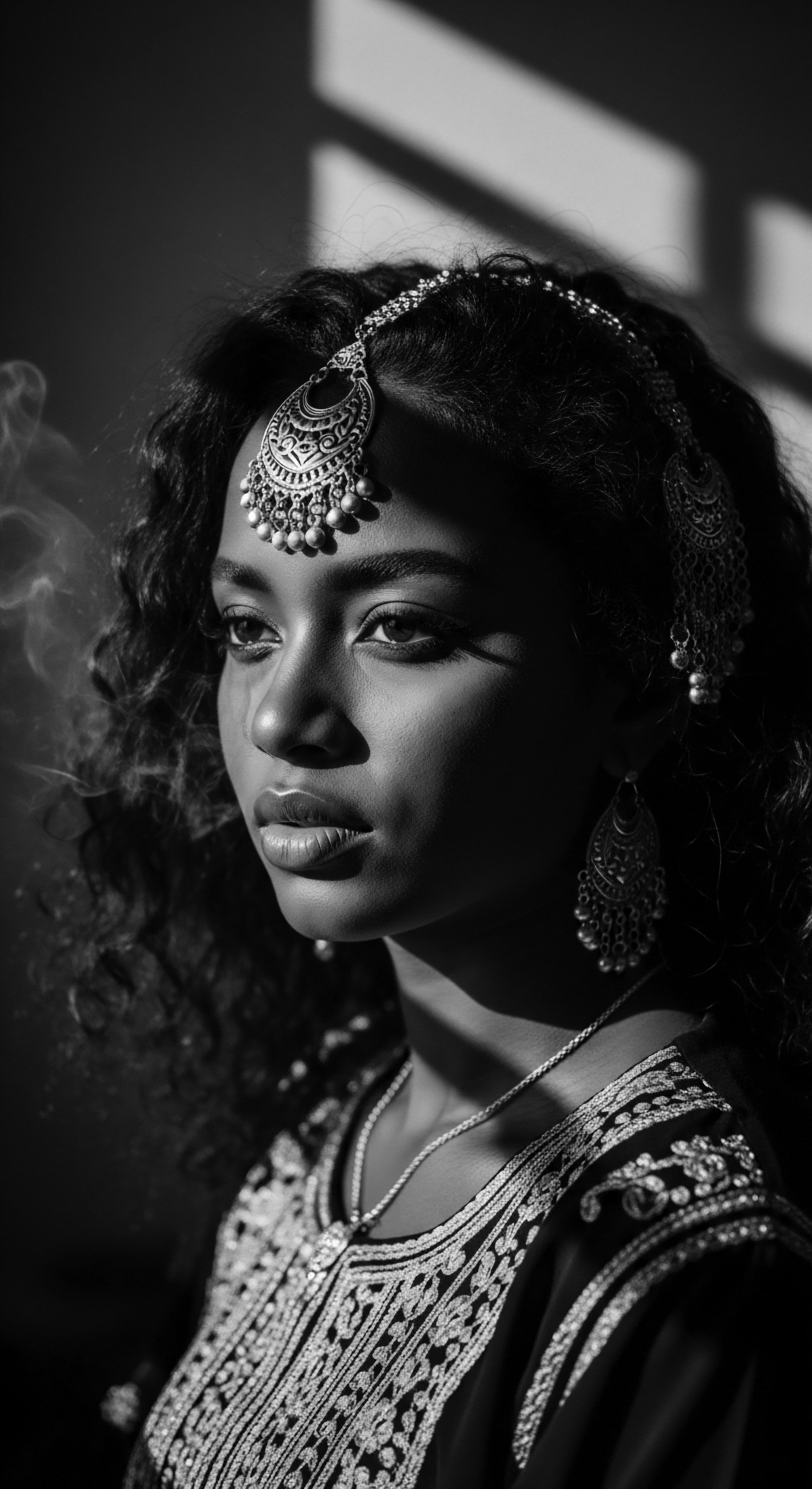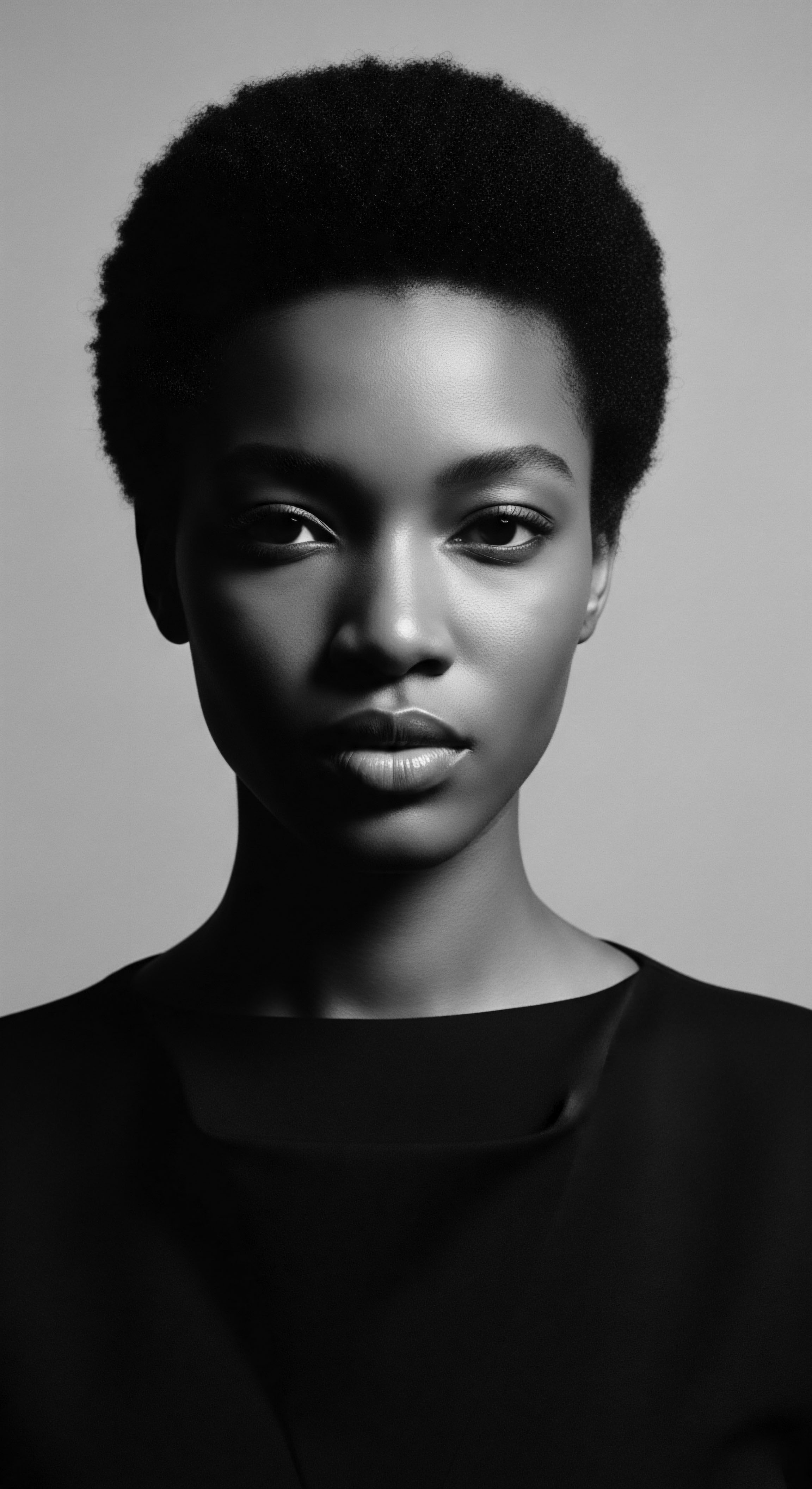
Roots
To journey into the heart of textured hair is to trace a lineage, to hear echoes from the source where every coil and curl tells a story. This exploration begins with an acknowledgment ❉ hair, in its purest form, is a biological marvel, yet for those of Black and mixed-race descent, it has always been far more. It stands as a profound connection to ancestral wisdom, a living marker of heritage that stretches back through time, across continents, and into the very fibers of identity. In this light, the headwrap emerges not merely as an accessory but as a central artifact within the vast archive of textured hair history, a testament to both its care and its enduring cultural significance.
The very structure of textured hair, characterized by its unique elliptical follicles and tightly wound helical shape, lends itself to specific needs and, historically, distinct care practices. Unlike straighter strands, these coiling patterns offer a natural inclination towards dryness due to the reduced ability of natural oils to descend the hair shaft. This inherent characteristic, understood intuitively by ancestors long before modern science articulated the sebaceous gland’s function, positioned protective measures as paramount.
Headwraps, in their earliest manifestations, served as an ingenious solution, shielding fragile strands from environmental elements—the sun’s intensity, the dry winds, or the omnipresent dust of daily life. This practical function, however, soon intertwined with deeper cultural meanings.
Consider the ancient kingdoms of Kemet and Kush, where elaborate hair designs were not merely aesthetic choices; they signified social standing, spiritual devotion, and even tribal affiliation. Hieroglyphic evidence points to Pharaohs covering their hair with wigs or headbands, and divine crowns for royalty often comprised finely woven cloth. For the Kushite people, natural hair textures were celebrated, styled in curls or tightly bound rows, reflecting a unique Nubian beauty standard. Within these societies, head coverings, whether elaborate ceremonial pieces or simpler daily wraps, acted as a continuation of the hair’s sacred nature, guarding it and extending its symbolism.
The headwrap, an ancient sentinel, guards the spirit of textured hair while tracing an unbroken line from ancestral wisdom to modern care.
The evolution of nomenclature for textured hair itself carries whispers of this past. While contemporary systems like Andre Walker’s categorizations (Type 4A, 4B, 4C) offer a scientific framework for understanding coil patterns, historical communities possessed their own lexicons, often intertwined with descriptors of status, health, and spiritual connection. The very terms used for hair and head coverings varied widely across African nations, each name a dialect of dignity:
- Gele ❉ A term for folded headwraps, common among the Yoruba people of Nigeria.
- Duku ❉ Used in Ghana and Malawi for headwraps.
- Dhuku ❉ The name for headwraps in Zimbabwe.
- Tukwi ❉ A term for headwraps in Botswana.
- Doek ❉ Employed in South Africa and Namibia.
- Tignon ❉ A distinct headcovering from Louisiana, historically worn by Creole women of African descent.
These distinctions in naming reflect the localized adaptations and profound cultural embedding of head coverings. Early practices for hair retention, often incorporating natural butters, herbs, and powders, were amplified by the use of scarves for both ceremonial wear and basic protection. The headwrap, then, became a complementary element in the larger narrative of hair preservation, a quiet guardian against the elements, allowing hair to flourish in its natural state. This initial layer of understanding, recognizing the headwrap’s practical and symbolic roots, sets the stage for a deeper exploration of its role in shaping textured hair heritage across time.

Ritual
Beyond its elemental protective function, the headwrap entered the realm of ritual, transforming into a living practice that spoke volumes without uttering a word. Its journey through the tapestry of textured hair heritage saw it evolve from a simple cloth into a profound statement, influencing and being shaped by the very styling traditions it protected. For Black and mixed-race communities, particularly within the African diaspora, the headwrap became a focal point for artistry, identity, and quiet defiance.
The styling of textured hair has always been a deliberate act, a ritual that often extended beyond mere aesthetics. Historically, hair designs communicated marital status, social rank, age, and even tribal identity. Protective styles, such as braids, twists, and cornrows, were not simply fashion choices; they were foundational care practices, reducing manipulation and shielding fragile hair from damage. The headwrap became an intrinsic part of this tradition, often worn over these styles to extend their longevity, offer an added layer of preservation, or simply to add a ceremonial finish.

How Have Headwraps Shaped Styling Techniques?
The very act of wrapping hair carries a historical cadence, an echo of communal grooming practices where women socialized and strengthened familial bonds. From West African traditions, where styles were crafted with deep spiritual significance by respected braiders, to the Himba tribe’s use of otjize paste with butterfat and ochre, protecting hair from the sun and insects while symbolizing a connection to ancestors, head coverings have always played a part. The integration of headwraps into protective styling is a testament to their practicality and cultural resonance.
They served as a barrier against friction, preserved moisture applied to the hair, and maintained the integrity of intricate styles for extended periods. This allowed for length retention, a constant challenge for highly coiling hair prone to breakage.
The sheer artistry of headwrapping developed into a sophisticated skill, with diverse styles specific to different regions and occasions. In many African cultures, the manner in which a headwrap was tied could indicate a woman’s social standing, a celebration of marriage or fertility, or even a period of mourning. These wraps were not static; they were dynamic expressions, adapting to changes in environment, social norms, and personal expression.
A headwrap transforms ordinary fiber into a canvas of cultural expression, echoing ancestral pride in every fold.
One powerful, albeit painful, historical example of the headwrap’s transformation from a symbol of status to one of resistance unfolded in 18th-century Louisiana. The Spanish Governor Esteban Rodríguez Miró enacted the Tignon Law in 1786. This decree mandated that Black women, particularly free women of color whose elaborate hairstyles and attire were perceived as a challenge to the colonial social order, cover their hair with a tignon or headscarf. The law aimed to enforce modesty, distinguish them from white women, and visually mark them as belonging to a subordinate class, whether enslaved or not.
What began as an act of oppression, however, became a profound display of resilience and creativity. Instead of succumbing to the law’s intention to diminish them, Black women in New Orleans transformed the tignon into an artistic statement. They utilized luxurious fabrics, vibrant colors, and intricate tying techniques, often decorating them with jewels and feathers. The tignon, intended as a badge of dishonor, became a mark of distinction, beauty, wealth, and defiance, a subtle rebellion against a government seeking to oppress them.
This historical episode vividly demonstrates how a practical item of hair covering was not just used for styling but became a powerful tool for cultural expression and resistance, deeply embedded in the heritage of textured hair. This moment, when forced concealment became a canvas for overt identity, speaks to the inherent power these coverings held.
The tools of hair care also evolved alongside headwrap traditions. While today we speak of satin-lined bonnets and specialized hair oils, ancestral toolkits included natural butters, plant-based cleansers, and various threads for protective styles. For instance, African Hair Threading, known as “Irun Kiko” among the Yoruba people, involves wrapping flexible threads around hair sections to stretch and protect them from breakage, a practice that existed as early as the 15th century. Headwraps and bonnets served as a further layer of protection, particularly during sleep, guarding these meticulously styled threads or natural curls.
| Historical Application Status Marker in West African Societies |
| Modern Parallel and Heritage Link Contemporary fashion statements reflecting cultural pride and identity. |
| Historical Application Protection from Sun and Dust |
| Modern Parallel and Heritage Link Moisture retention and friction reduction for delicate strands. |
| Historical Application Symbol of Resistance (Tignon Laws) |
| Modern Parallel and Heritage Link Empowerment against Eurocentric beauty standards. |
| Historical Application Communal Grooming Rituals |
| Modern Parallel and Heritage Link Shared self-care practices within natural hair communities. |
| Historical Application The headwrap's journey showcases an unbroken line of adaptability and enduring heritage in textured hair care. |
The ritual of selecting a fabric, the purposeful tying, and the subsequent wearing of a headwrap extends beyond mere habit. It is a dialogue with the past, a continuation of practices that ensured the longevity and vitality of textured hair, while simultaneously broadcasting messages of resilience, beauty, and belonging within Black and mixed-race communities.

Relay
The journey of the headwrap from ancient utility to a profound cultural statement is a relay race through generations, each passing the baton of heritage, knowledge, and meaning. It is within this relay that the deeper complexities of headwraps, textured hair, and modern care intersect, revealing how ancestral wisdom, often intuitive, finds validation in contemporary scientific understanding. This ongoing dialogue between past and present allows for a nuanced appreciation of textured hair as a biological entity, a cultural artifact, and a symbol of enduring identity.
Modern hair science has shed light on the unique properties of textured hair, particularly its susceptibility to dryness and breakage due to the cuticle structure and elliptical shape of the hair shaft. This scientific understanding, however, merely articulates what ancestral practitioners knew through generations of lived experience ❉ textured hair thrives on protection and moisture. Here, the headwrap steps forward as a silent collaborator in the regimen of radiance, a tangible link between ancient wisdom and current best practices.

How Does Headwrap Science Mirror Ancient Practices?
The efficacy of headwraps in modern textured hair care routines—particularly those worn at night—directly mirrors their historical protective functions. A satin or silk-lined bonnet or wrap minimizes friction against abrasive surfaces like cotton pillowcases, which can strip moisture and cause tangles and breakage, especially for fragile hair ends. This scientific principle of reducing mechanical stress was implicitly understood in traditional practices where protective styles like Bantu knots or braids were often covered to maintain their integrity and keep hair tidy in challenging climates. The ancient understanding was about preserving the hair’s condition for longevity and health, a direct precursor to modern calls for “length retention” and “moisture sealing.”
Consider the use of traditional ingredients, such as Shea Butter, derived from the Karite tree. For centuries, this butter has been used as a skin and hair moisturizer, known for its ability to trap moisture and restore damaged skin. In Chad, women historically mixed Chébé powder with moisturizing substances like Shea butter, applying it to hydrated hair and then braiding it to lock in moisture and keep hair protected.
The headwrap or covering then served to keep these nourishing treatments undisturbed, allowing them to fully penetrate and condition the hair. This seamless integration of natural ingredients, protective styling, and head coverings speaks to a holistic approach to hair wellness that is deeply rooted in heritage and scientifically sound.
The silent strength of a headwrap embodies a cultural continuum, whispering tales of resilience from past to present.
The significance of headwraps extends into the realm of psychosocial well-being, serving as a powerful symbol of identity and resistance against historical pressures to conform to Eurocentric beauty standards. During the transatlantic slave trade, enslavers often shaved the hair of enslaved Africans to dehumanize them and erase their cultural identity. Post-emancipation, various laws, like the Tignon Laws, continued to police Black women’s hair. Yet, in every instance, the headwrap became a defiant statement.
It was a way to reclaim self, assert presence, and celebrate textured hair in a society that sought to denigrate it. This psychological resilience, the ability to transform a tool of oppression into a beacon of cultural pride, is a crucial aspect of the headwrap’s heritage.
The contemporary natural hair movement, which gained significant momentum in the 2000s, represents a resurgence of this ancestral wisdom. It is a collective embrace of natural textures and a conscious decision to move away from chemical relaxers and perms that dominated much of the 20th century. Within this movement, the headwrap has experienced a powerful renaissance, not just as a fashion accessory but as a conscious connection to ancestry, a signifier of cultural affirmation, and a practical element of a healthy hair regimen.
Laws like the CROWN Act in the United States, aimed at protecting individuals from discrimination based on race-based hairstyles, are a modern echo of the historical struggle for hair autonomy and dignity. The headwrap, in this context, serves as a visible symbol of this ongoing fight and triumph.
The interplay of genetics, environment, and historical context informs the deep understanding of textured hair. The specific structure of hair follicles in individuals of African descent, creating tightly coiled strands, means hair is often weaker when wet and requires careful detangling. Protective styles, often augmented by the use of headwraps, mitigate these challenges. The headwrap thus becomes an extension of the hair itself, a silent guardian that allows for length retention and reduces the need for frequent manipulation, aligning perfectly with the core principles of holistic textured hair care.
The stories woven into the fabrics of headwraps are as diverse as the communities that wear them. From the Fulani women displaying wealth and marital status through their intricately woven braids adorned with cowrie shells to the Yoruba spiritual significance of specific hairstyles, the headwrap has always been a vessel for cultural information. The relay continues today, as new generations discover the practicality and heritage of headwraps, integrating them into routines that honor both the wisdom of their ancestors and the advancements of modern care. This ongoing dialogue ensures that the legacy of textured hair care, with the headwrap at its core, remains a living, evolving tradition.

Reflection
As our journey through the living archive of textured hair draws to a close, a singular truth shines with unwavering clarity ❉ the headwrap, in all its iterations, stands as a testament to an enduring heritage. It is a symbol woven with strands of resilience, beauty, and wisdom, connecting contemporary care practices to the deepest ancestral roots. From the elemental biology of coiled hair to the profound cultural narratives of identity and resistance, the headwrap embodies the ‘Soul of a Strand’—the recognition that hair is not merely a biological appendage but a vibrant keeper of history, a canvas for selfhood, and a conduit to communal legacy.
Modern understanding of textured hair, with its scientific insights into moisture retention and cuticle health, finds its historical parallel in the intuitive genius of those who came before. The careful tying of a headwrap at dusk, the selection of a fabric that speaks to lineage, the very act of covering one’s crown—these are not relics of a distant past but living practices, passed down through the generations. They remind us that true care is holistic, encompassing not just the physical well-being of the hair but its spiritual and cultural resonance.
The headwrap’s continued presence in communities of Black and mixed-race individuals across the globe speaks to its adaptability, its quiet power to adapt to shifting times while steadfastly holding onto its foundational meaning. It stands as a bridge, allowing the wisdom of our forebears to gently guide our present-day practices, ensuring that the heritage of textured hair continues to flourish, unbound and radiant, for all time.

References
- Ademefun, Sharon. “A Brief History Of Black Hair Rituals.” ELLE, 2020.
- Afriklens. “African Hairstyles ❉ Cultural Significance and Legacy.” Afriklens, 2024.
- Gould, Virginia M. “The Devil’s Lane ❉ Sex and Race in the Early South.” Oxford University Press, 1996.
- Leone Culture. “Exploring the Significance Of Headwraps In African Fashion And Traditions.” Leone Culture, 2023.
- Library of Congress. “Heavy is the Head ❉ Evolution of African Hair in America from the 17th c. to the 20th c.” Library of Congress, 2023.
- Mawu Africa. “From Tradition to Fashion ❉ The Evolution of African Head Wraps.” Mawu Africa, 2023.
- The New York Historical. “Fashionable Rebellion – Women & the American Story.” The New York Historical, 2023.
- Obscure Histories. “Ancient Gems ❉ A Historical Survey of African Beauty Techniques.” Obscure Histories, 2024.
- Sonson. “The History of Headwraps and Black Culture.” Sonson, 2021.
- SUSU. “Black History Month ❉ Loving Natural Afro-Hair.” SUSU, 2023.
- TANTV. “Beyond Beauty ❉ The History of Bantu Knots.” TANTV, 2024.
- VICE. “When Black Women Were Required By Law to Cover Their Hair.” VICE, 2018.
- Wikipedia. “Kinky hair.” Wikipedia, 2024.
- Wikipedia. “Tignon law.” Wikipedia, 2024.
- Wilderness. “The history & meaning of head wraps across Africa.” Wilderness, 2015.
